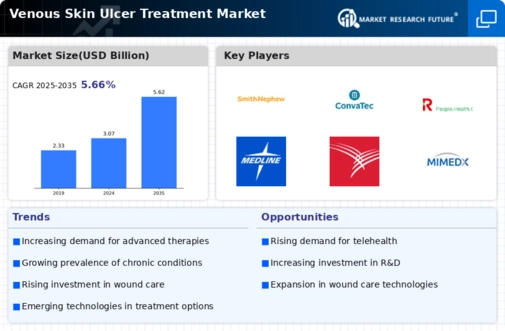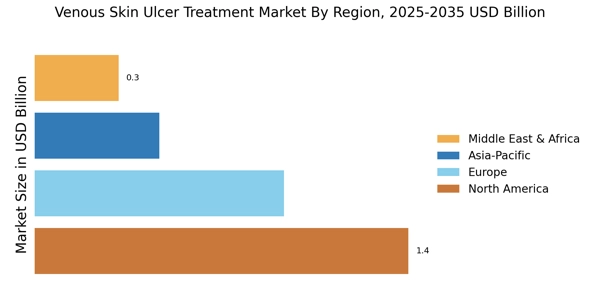Rising Healthcare Expenditure
The increase in healthcare expenditure across various regions is a significant driver for the Venous Skin Ulcer Treatment Market. Governments and private sectors are investing more in healthcare infrastructure, leading to improved access to treatment options for patients suffering from venous skin ulcers. Data suggests that healthcare spending is expected to rise by approximately 5% annually, which will likely enhance the availability of advanced treatment options. This financial commitment enables healthcare facilities to procure innovative products and technologies, thereby improving patient care. As healthcare expenditure continues to grow, the Venous Skin Ulcer Treatment Market is poised to benefit from enhanced investment in treatment solutions.
Advancements in Treatment Technologies
Technological advancements in treatment modalities are significantly influencing the Venous Skin Ulcer Treatment Market. Innovations such as bioengineered skin substitutes, advanced dressings, and negative pressure wound therapy are enhancing healing outcomes for patients. The introduction of these technologies has been associated with reduced healing times and improved patient satisfaction. Market data indicates that the adoption of advanced wound care products is on the rise, with a projected growth rate of over 6% annually. These advancements not only improve clinical outcomes but also reduce healthcare costs associated with prolonged treatment. As healthcare providers increasingly adopt these technologies, the Venous Skin Ulcer Treatment Market is likely to experience robust growth.
Shift Towards Home Healthcare Solutions
The shift towards home healthcare solutions is emerging as a key driver for the Venous Skin Ulcer Treatment Market. With an increasing number of patients preferring to receive care in the comfort of their homes, there is a growing demand for portable and user-friendly treatment options. Home healthcare services are becoming more prevalent, allowing patients to manage their venous skin ulcers effectively outside of traditional clinical settings. Market data indicates that the home healthcare market is expected to grow significantly, with a projected increase of over 7% annually. This trend is likely to drive innovation in treatment products tailored for home use, thereby expanding the Venous Skin Ulcer Treatment Market.
Increasing Prevalence of Venous Diseases
The rising incidence of venous diseases, particularly venous skin ulcers, is a primary driver for the Venous Skin Ulcer Treatment Market. Factors such as an aging population and lifestyle changes contribute to this trend. According to recent data, venous ulcers affect approximately 1% of the adult population, with higher rates observed in older adults. This growing patient demographic necessitates effective treatment options, thereby propelling market growth. The increasing awareness of venous diseases among healthcare professionals and patients further emphasizes the need for innovative treatment solutions. As the prevalence of these conditions continues to rise, the demand for specialized products and therapies within the Venous Skin Ulcer Treatment Market is expected to expand significantly.
Growing Awareness and Education Initiatives
The increasing awareness and education initiatives regarding venous skin ulcers are driving the Venous Skin Ulcer Treatment Market. Healthcare organizations and advocacy groups are actively promoting knowledge about the prevention and management of venous ulcers. This heightened awareness is leading to earlier diagnosis and treatment, which is crucial for effective management. Educational programs targeting both healthcare professionals and patients are becoming more prevalent, contributing to a better understanding of the condition. As awareness grows, the demand for effective treatment options is likely to increase, thereby positively impacting the Venous Skin Ulcer Treatment Market.


















Leave a Comment